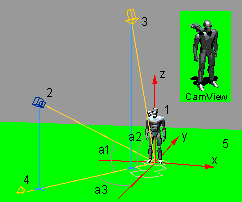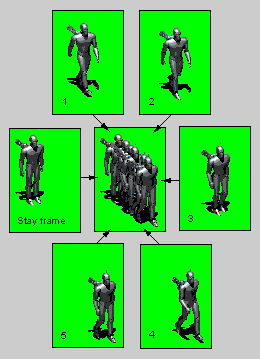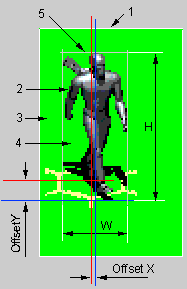Create a character model[]
Start with a 3D model of a character
Set up the scene for animation[]
| Reference Guide | |
|---|---|
| Reference | Description |
| 1 | character model |
| 2 | camera ('Orthographic Projection' - 3ds Max) |
| 3 | light source to create shadows of the character on the ground ('Cast Shadows', 'Use Ray-Traced Shadows', 'Decay' to 'None') |
| 4 | arbitrary light source to create ambient lighting ('Cast Shadows' off, 'Decay' to 'None') |
| 5 | horizontal plane to form the background color and shadows on the final image |
| a1 | vertical camera angle (-25.7 degrees) |
| a2 | angle of the light source for shadows (-75.7 degrees) |
| a3 | horizontal camera angle (-150, -90, -30, 30, 90, and 150 for six orientations). |
Generate frames[]
An animation set of five frames in the 'South East' (SE) orientation. For rendering, disable Anti-Aliasing. Notice that The "stay frame" is not included in animation set 'AB', but is included in the 'AA' set.
Create the animation project[]
A single frame
| Reference Guide | |
|---|---|
| Reference | Description |
| 1 | the actual dimensions of the picture |
| 2 | target character image |
| 3 | empty border. (Do not cut them yourself. They are needed to correctly calculate the displacement of the logical boundaries of frames relative to each other. FrameAnimator pairs these empty areas together itself just before the generation of .FRM file, if you set the option 'Edit\Options...\Autocutting') |
| 4 | background, interpreted as transparent |
| 5 | the logical boundary of the frame (If the option FrameAnimator 'Edit\Options...\Autocutting' is not enabled, then the logical boundary coincides with the actual dimensions of the picture. For the different frames in the collection the logical boundaries are different) |
| H, W | height and width of the frame |
| OffsetX, OffsetY | the offset of the logical center (in FrameAnimator the values FramesOffset[direction].X and FramesOffset[direction].Y).
Offset X is measured from the center of the image, and Offset Y is measured from the bottom edge. |
Finish the animation[]
| Reference Guide | |
|---|---|
| Reference | Description |
| 1 | standing character frame (not included in the walking animation) |
| 2 | walking animation frames |
| 3 | repeated walk animation frames (played repeatedly until the character reaches the desired location on the map) |
| dx1, dy1 | the offset of the first frame at the beginning of the animation: FirstOffset[direction].X = FramesOffsets[direction].X + FrameOffsets[direction][1].X |
| dx2, dy2 | the offset between two adjacent frames (In FrameAnimator these are the values FrameOffset[direction][i].X and FrameOffset[direction][i].Y . FrameAnimator can calculate them automatically, if not trim the empty background of images!) |
| dx3, dy3 | the offset between the last frame and first frame in the repeated animation (in FrameAnimator these are the values FrameOffset[direction][1].X and FrameOffset[direction][1].Y . Set the value of X and use the 'OffsetWizard' button in the 'FrameOffset' dialog box to calculate the correct value of Y). |
External Link[]
Original document: http://www.jochua.nm.ru/docs/frmantr.htm (in Russian)





